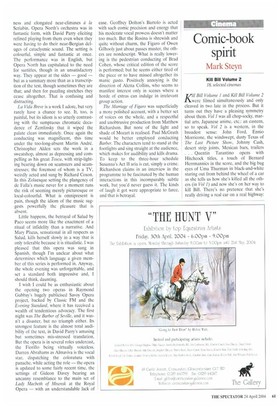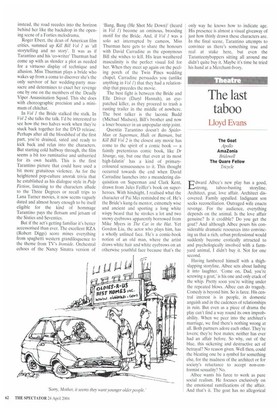Comic-book spirit
Mark Steyn
Kill Bill Volume 2 IS, selected cinemas
Val Bill Volume 1 and Kill Bill Volume 2 ilwere filmed simultaneously and only cleaved in two late in the process. But it turns out they have a pleasing symmetry about them. Vol 1 was all chop-socky, martial arts, Japanese anime, etc.: an eastern, so to speak. Vol 2 is a western, in the broadest sense: John Ford, Ennio Morricone, the windswept, dusty Texas of The Last Picture Show, Johnny Cash, desert strip joints, Mexican bars, trailers . . Quentin Tarantino opens with Hitchcock titles, a touch of Bernard Herrmannics in the score, and the big bug eyes of Uma Thurman in black-and-white staring out from behind the wheel of a car as she tells us how she's killed all the others (in Vol 1) and now she's on her way to kill Bill. There's no pretence that she's really driving a real car on a real highway:
instead, the road recedes into the horizon behind her like the backdrop in the opening scene of a Forties melodrama.
Roger Ebert, the dean of American film critics, summed up Kill Bill Vol / as 'all storytelling and no story'. It was as if Tarantino and his 'co-writer' Thurman had come up with as slender a plot as needed for a virtuoso display of technique and allusion. Miss Thurman plays a bride who wakes up from a coma to discover she's the only survivor of her wedding-party massacre and determines to exact her revenge one by one on the members of the Deadly Viper Assassination Squad. This she does with choreographic precision and a minimum of chitchat.
In Vol 1 the Bride stalked the stalk. In Vol 2 she talks the talk. I'd be interested to see how the two halves work when they're stuck back together for the DVD release. Perhaps after all the bloodshed of the first part, you're drained, sated and ready to kick back and relax into the characters. But starting cold halfway through, the film seems a bit too ruminative and unhurried for its own health. This is the first Tarantino picture that could have used a bit more gratuitous violence. As for the heightened pop-culture anorak trivia that he established as his dialogue style in Pulp Fiction, listening to the characters allude to the Three Degrees or recall trips to Lana Turner movies, it now seems vaguely dated and almost hoary enough to be itself eligible for the kind of hommage Tarantino pays the flotsam and jetsam of the Sixties and Seventies.
But if the act's getting familiar it's better accessorised than ever. The excellent RZA (Robert Diggs) score mines everything from spaghetti western grandiloquence to the theme from TV's Ironside. Orchestral echoes of the Nancy Sinatra version of 'Bang, Bang (He Shot Me Down)' (heard in Vol 1) become an ominous, brooding motif for the Bride. And, if Vol 1 was a solo act interrupted by cameos, Miss Thurman here gets to share the honours with David Carradine as the eponymous Bill she wishes to kill. His lean weathered masculinity is the perfect visual foil for her. When they meet up again on the peeling porch of the Twin Pines wedding chapel, Carradine persuades you (unlike anything in Vol 1) that they had a relationship that precedes the movie.
The best fight is between the Bride and Elle Driver (Daryl Hannah), an eyepatched killer, as they proceed to trash a rusting trailer in the middle of nowhere. The best talker is the laconic Budd (Michael Madsen). Bill's brother and now a loser bouncer in an unpopular strip joint.
Quentin Tarantino doesn't do SpiderMan or Superman, Hulk or Batman, but Kill Bill Vol 2 is the closest any movie has come to the spirit of a comic book — a faintly pretentious comic book, like Dr Strange, say, but one that even at its most high-falutin' has a kind of primarycoloured sensuousness to it. This thought occurred towards the end when David Carradine launches into a meandering disquisition on Superman and Clark Kent, drawn from Jules Feiffer's book on superheroes. With hindsight, I realised what the character of Pai Mei reminded me of. He's the Bride's kung-fu mentor, extremely wise and ancient and sporting a long white wispy beard that he strokes a lot and two snowy eyebrows apparently borrowed from Mike Myers in The Cat in the Hat. Yet Gordon Liu, the actor who plays him, has a wholly unlined face. He's a comic-book notion of an old man, where the artist draws white hair and white eyebrows on an otherwise youthful face because that's the
only way he knows how to indicate age. His presence is almost a visual giveaway of just how thinly drawn these characters are. In the final scene, Tarantino attempts to convince us there's something true and real at stake here, but even the Taranteenyboppers sitting all around me didn't quite buy it. Maybe it's time he tried his hand at a Merchant-Ivory.



















































































 Previous page
Previous page